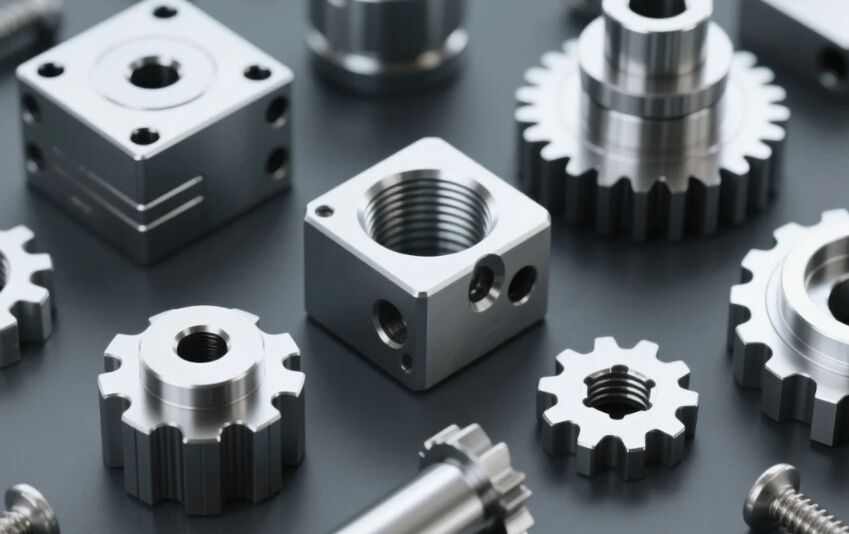What are the examples of CNC machined parts
Ever wonder what parts CNC machining actually makes? Discover concrete examples from aerospace engines to medical implants and the car in your driveway. Learn why CNC is everywhere!
Hey there! Ever looked at a complex metal or plastic part – maybe in your car, your phone, or even a medical device – and wondered, "How on earth was this made?" Chances are incredibly high that the answer is CNC machining. It's the quiet powerhouse behind so much of modern manufacturing.
You might have heard the term "CNC" thrown around, but what does it actually produce? Let's move beyond the technical jargon and explore the real, tangible examples of CNC machined parts that shape our world. This stuff isn't just theoretical; it's in the products we use and rely on every single day.
What is CNC Machining?
Before we jump into examples, a lightning-fast reminder: CNC stands for Computer Numerical Control. Think of it as ultra-precise robotic sculpting. A computer program guides cutting tools to remove material from a solid block (metal, plastic, etc.), transforming it into a highly accurate, complex part. It's all about precision, repeatability, and handling complexity that manual methods just can't match.

Why CNC Reigns Supreme: A Quick Nod to the Advantages
Why is CNC machining used for so many critical parts? A few key reasons:
- Pinpoint Accuracy & Repeatability: Need a part identical to the last 10,000? CNC delivers, holding tolerances finer than a human hair.
- Complexity Made Possible: Intricate shapes, internal channels, fine details? CNC machines eat these for breakfast, where manual machining would struggle or fail.
- Speed & Efficiency: Once programmed, CNC machines work fast and consistently, 24/7 if needed, significantly boosting production.
- Material Versatility: From tough metals like titanium to engineering plastics and even wood, CNC handles a vast range .
- Reduced Human Error & Safer: Automation minimizes mistakes and keeps operators safer by reducing direct interaction with cutting tools.
Now, Let's Get Concrete: Examples of CNC Machined Parts by Industry
This is where it gets exciting. CNC parts are absolutely everywhere. Here's a breakdown by some major sectors:
1. Taking Flight & Reaching Space: Aerospace CNC Parts
The aerospace industry demands absolute perfection. Lives depend on it. CNC machining is essential here because of its ability to meet incredibly tight tolerances and produce complex, high-strength, lightweight components .
- Engine Components: Turbine blades (which endure insane heat and stress), engine mounts, fuel system bodies .
- Structural Elements: Wing spars, ribs, brackets, fuselage frames – the literal skeleton of the aircraft .
- Landing Gear: Critical parts like struts, actuators, and structural housings that must withstand immense impact .
- Flight Control Systems: Hydraulic manifold blocks (controlling fluid flow for movement), actuator components .
- Avionics Enclosures: Precision housings for sensitive navigation and communication electronics .
2. On the Road: Automotive CNC Parts (From Prototype to Production)
Whether it's a high-performance supercar or your daily commuter, CNC machining plays a massive role in the automotive world, from prototyping new designs to manufacturing high-volume production parts .
- Engine Core: Engine blocks, cylinder heads, connecting rods, crankshafts, camshafts, valve bodies – the heart of the vehicle .
- Transmission Systems: Gears, shafts, housings, clutch components .
- Suspension & Steering: Control arms, steering knuckles, ball joints, bushings, rack and pinion components .
- Braking System: Caliper brackets, master cylinder housings, ABS module components .
- Exhaust Systems: Manifolds, flanges, sensor housings .
- Interior & Electronics: Custom brackets, dashboard components, sensor housings .
(Real-World Impact: Companies like Ford, GM, Toyota, and Tier 1 suppliers heavily rely on CNC machining for both prototyping and producing these critical components .)
3. Saving Lives & Improving Health: Medical CNC Parts
Precision in the medical field isn't just about quality; it's often life-or-death. Biocompatibility and extreme accuracy are non-negotiable, making CNC machining a cornerstone technology .
- Surgical Instruments: Scalpels, forceps, bone rasps, specialized clamps – requiring sharpness, ergonomics, and sterilizability .
- Implants: Orthopedic implants like titanium knee or hip replacements, spinal fusion devices, dental implants .
- Diagnostic Equipment: Components for MRI machines, CT scanners, X-ray systems, including shielding and precision motion stages .
- Prosthetics & Orthotics: Customized sockets, joints, and structural components .
- Medical Device Housings: Enclosures for pumps, monitors, and analyzers, often needing electromagnetic shielding .
4. Powering the World: Energy Industry CNC Parts
From traditional fossil fuels to renewables, the energy sector relies on robust, reliable components often operating in harsh environments. CNC machining delivers .
- Turbine Components: Blades, nozzles, seals, and discs for gas, steam, wind, and hydro turbines .
- Pump & Valve Bodies: Critical parts controlling fluid flow in pipelines, refineries, and power plants .
- Heat Exchangers: Complex internal channel plates and manifolds .
- Drilling Equipment: Components for downhole tools, drill string adapters, sensor housings .
- Renewable Energy: Components for solar panel tracking systems, wind turbine gearboxes and hubs, geothermal plant valves .
5. Electronics & Consumer Goods: The Unseen Precision
Look inside almost any sophisticated electronic device or high-quality consumer product, and you'll find CNC machined parts enabling functionality and sleek design .
- Heat Sinks: Intricately finned aluminum or copper blocks keeping CPUs and GPUs cool .
- Enclosures & Housings: Precision cases for laptops, routers, servers, and consumer electronics .
- Connectors & Sockets: Precision electrical contacts and housings .
- Optics Mounts: Precise fixtures for lenses and sensors in cameras and scientific equipment.
- Appliance Components: Internal gears, pump parts, compressor components in refrigerators, washing machines, etc. .
6. Industrial Machinery & Beyond: The Backbone of Manufacturing
CNC machining quite literally builds the machines that build everything else.
- Robotic Components: Arms, joints, end-effector mounts requiring high rigidity and precision .
- Machine Tool Components: Spindles, ball screws, linear slide components, tool holders.
- Mold & Die Components: Inserts and cores for injection molding and die casting .
- Custom Automation: Fixtures, jigs, and specialized components for assembly lines.
- General Hardware: High-precision shafts, couplings, gears, fasteners (specialized bolts/nuts), brackets .
Materials Matter: What Are These Parts Made From?
The examples above are made possible because CNC works with a huge variety of materials, chosen for specific properties:
- Metals: Aluminum (lightweight, strong), Stainless Steel (corrosion resistant), Titanium (super strong, lightweight, biocompatible), Brass, Copper, Steel Alloys, Inconel (heat resistant).
- Plastics: ABS (tough), Nylon (wear resistant), Polycarbonate (impact resistant), PEEK (high-temp, biocompatible), PTFE (low friction), Acrylic (PMMA - clear).
- Others: Composites (like carbon fiber reinforced plastics), Wood, Foam (for prototyping).
The Flip Side: Challenges in CNC Machining (It's Not Magic!)
While incredibly powerful, CNC machining isn't without its hurdles. Acknowledging these shows a realistic understanding :
- Complex Geometries: Extremely intricate shapes can be challenging to fixture and machine without distortion or increased cost.
- Heat Generation: Machining, especially metals at high speeds, generates heat that can affect the part and tool life, requiring careful control.
- Tooling & Setup: Choosing the right cutting tools and fixturing is critical and requires expertise. Tool wear must be managed.
- Programming Complexity: Creating efficient, error-free CNC programs (G-code) is a specialized skill. Poor programming leads to scrap parts.
- Initial Cost & Expertise: CNC machines and skilled programmers/operators represent a significant investment.
- Material Waste (Subtractive): Starting with a solid block means material is removed and often wasted, unlike additive (3D printing).
The Future is Cutting-Edge: Where CNC is Headed
CNC machining isn't standing still. Exciting trends are shaping its future:
- Smarter with AI & Automation: Machines are getting smarter! AI is optimizing toolpaths in real-time, predicting maintenance needs, and improving quality control. Automation integration (robots loading/unloading) enables lights-out manufacturing.
- Hybrid Manufacturing: Combining CNC machining (subtractive) with 3D printing (additive) in one machine offers incredible flexibility – building near-net shapes additively and then CNC machining critical features with high precision.
- Even Higher Speeds & Precision: Pushing the boundaries further for efficiency and capabilities in micro-machining
- Advanced Materials: CNC machines are being adapted to handle even more challenging materials like advanced ceramics and new composites.
- Sustainability Focus: Efforts to reduce energy consumption, utilize coolant more efficiently (e.g., minimum quantity lubrication), and recycle metal chips.
- Digitalization & Connectivity: Integration into the Industrial Internet of Things (IIoT) for real-time monitoring and data-driven decision making..
CNC Machining - The Invisible Artisan
So, the next time you drive your car, fly on a plane, visit a doctor, use your phone, or even turn on a light, remember the vast array of CNC machined parts working silently and precisely behind the scenes. From the massive engine block to the tiny implant in a knee, CNC machining is fundamental to modern life. It's the perfect blend of digital control and physical craftsmanship, transforming raw materials into the complex components that drive innovation across every industry. It's truly the invisible artisan shaping our tangible world.


